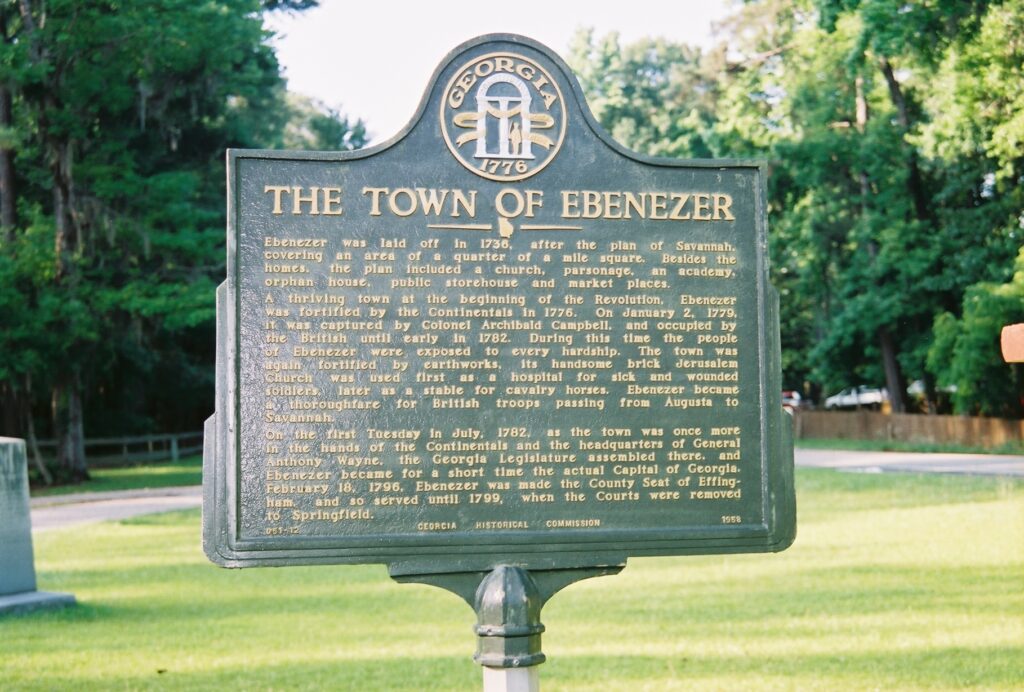Georgia Salzburgers
The Georgia Greiners were part of a religious group of German-speaking Lutherans called Salzburgers. The Catholic Archbishop Court Firmian in 1731 issued the Edict of Expulsion because the Protestants of the Province of Salzburg continued to follow the teachings of Martin Luther. Lutheran Pastor Samuel Ulrsperger of Ausburg (present day Germany) and his organization sought refuge for these tormented people. King George, who himself was a Lutheran, empathized with these people and their hardships. He offered them a new home in the new colony of Georgia in America.
The first groups of Salzburgers refugees left England for their journey in January 1734 on the ship named the Purysburg, under Captain Tobias Pry. The voyage to the New World lasted 63 days. When the ship arrived at the Savannah River, the founder of the Georgia Colony General James Oglethorpe greeted them. Several hundred Salzburgers continued to arrive until 1752.
The name for their town Ebenezer came from the Salzburger Pastors. The story goes that during a terrible storm near the end of their voyage, they were reading from the Bible. Among these readings, was I Samuel 7:12 where Samuel placed a stone where God had saved his people from their enemy. He named the stone Eben Ezer meaning stone of help. General James Oglethorpe named the town, its stream, and the Parish Ebenezer. This first Ebenezer settlement was in Purrysburg, South Carolina. It failed due to being too far inland, the soil was infertile, and no clear waterway existed to the Savannah River. Damp conditions also caused sickness and death the first two years. The settlement moved to Georgia and the Greiners were among the first families to settle there.
The Salzburgers organized the first church and orphanage in Georgia; and built the first grist mill, rice mill, saw mill, and silk business in the state of Georgia. The Jerusalem Evangelical Lutheran Church was completed in 1769 from formed clay bricks dug from the banks of the Savannah River. British troops occupied the area and used the church for a hospital. They burned the pews, the library including the Bible, and the church journals. There are several bullet holes remaining from the Revolutionary War. The British soldiers plundered patriot homes and targeted them for canon practice. The British left the settlement in ruins and it never recovered. During the Civil War, Sherman and his Union troops occupied the church in 1864. Again, pews and old hymn books were burned. The Georgia Germans were pressured to assimilate after the Revolution and many surnames were Anglicized and no longer German.
For more information, please visit The Georgia Salzburger Society Web Page

INSCRIPTION FROM MARKER Ebenezer was laid off in 1736, after the plan of Savannah, covering an area of a quarter mile square. Besides the homes, the plan included a church, parsonage, an academy, orphan house, public storehouse and market places. A thriving town at the beginning of the Revolution, Ebenezer was fortified by the Continentals in 1776. On January 2, 1779, it was captured by Colonel Archibald Campbell, and occupied by the British until early 1782. During this time the people of Ebenezer were exposed to every hardship. The town was again fortified by earthworks, its handsome brick Jerusalem Church was used first as a hospital for sick and wounded soldiers, later as a stable for cavalry. Ebenezer became a thoroughfare for British troops passing from Augusta to Savannah. On the first Tuesday in July 1782, as the town was once more in the hands of the Continentals and headquarters of General Anthony Wayne, the Georgia Legislature assembled there, and Ebenezer became for a short time the actual capitol of Georgia. February 18, 1796, Ebenezer was made the County seat of Effingham, and so served until 1799, when the Courts were moved to Springfield.